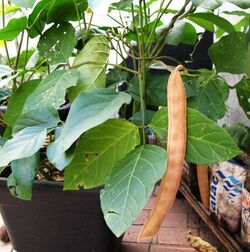Biology:Non-protein amino acid-accumulating clade
| Non-protein amino acid-accumulating clade | |
|---|---|

| |
| Canavalia ensiformis, from which canavanine was first isolated | |
| Scientific classification | |
| Kingdom: | Plantae |
| Clade: | Tracheophytes |
| Clade: | Angiosperms |
| Clade: | Eudicots |
| Clade: | Rosids |
| Order: | Fabales |
| Family: | Fabaceae |
| Subfamily: | Faboideae |
| Clade: | Meso-Papilionoideae |
| Clade: | Non-protein amino acid-accumulating clade (Cardoso et al 2012)[1] |
| Clades[1][2] | |
| |
| Synonyms | |
| |
The non-protein amino acid-accumulating clade, also known as the Canavanine-accumulating clade is a clade of the flowering plant subfamily Faboideae (or Papilionoideae) that includes the majority of agriculturally-cultivated legumes.[3][4][1] It is characterized by the accumulation of the non-proteinogenic amino acid canavanine in the seeds—a deterrent against herbivory. This phylogenetic trait was first recognized in the early 1980s.[5] This clade is consistently resolved in molecular phylogenies.[3][4][2] It contains many economically important genera, including Cicer, Glycine, Medicago, Phaseolus, Trifolium, Vicia, and Vigna.
Description
This clade circumscribes five subordinate clades: two traditional tribes (Hypocalypteae and Indigofereae) and three informal clades (the mirbelioids, the millettioids, and Hologalegina), as well as several minor taxa.[2] The name of this clade is informal and is not assumed to have any particular taxonomic rank like the names authorized by the ICBN or the ICPN.[1] The clade does not currently have a node-based definition.
See also
- IRL, another clade defined by molecular characteristics, rests within the NPAAA clade
References
- ↑ 1.0 1.1 1.2 1.3 Wojciechowski MF. (2013). "Towards a new classification of Leguminosae: Naming clades using non-Linnaean phylogenetic nomenclature". S Afr J Bot 89: 85–93. doi:10.1016/j.sajb.2013.06.017.
- ↑ 2.0 2.1 2.2 "Reconstructing the deep-branching relationships of the papilionoid legumes". S Afr J Bot 89: 58–75. 2013. doi:10.1016/j.sajb.2013.05.001. http://repository.uwc.ac.za/xmlui/bitstream/10566/3193/1/Cardoso_Reconstructing-the_2013.pdf.
- ↑ 3.0 3.1 "A phylogeny of legumes (Leguminosae) based on analysis of the plastid matK gene resolves many well-supported subclades within the family". Am J Bot 91 (11): 1846–862. 2004. doi:10.3732/ajb.91.11.1846. PMID 21652332.
- ↑ 4.0 4.1 "Revisiting the phylogeny of papilionoid legumes: new insights from comprehensively sampled early-branching lineages". Am J Bot 99 (12): 1991–2013. 2012. doi:10.3732/ajb.1200380. PMID 23221500.
- ↑ Bell EA. (1981). "Non-protein amino acids in the Leguminosae". Advances in Legume Systematics, Part 2. Kew, UK: Royal Botanic Gardens. pp. 489–499. ISBN 9780855212247. http://www.kewbooks.com/asps/ShowDetails.asp?id=318.
Wikidata ☰ Q16986600 entry
 |

